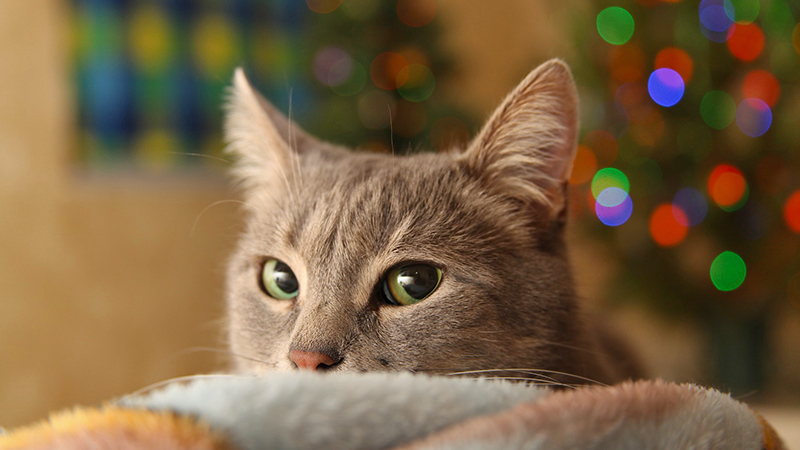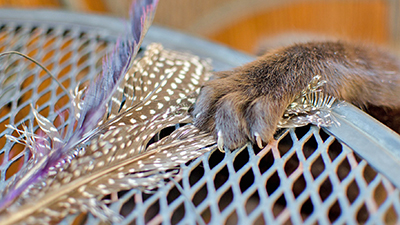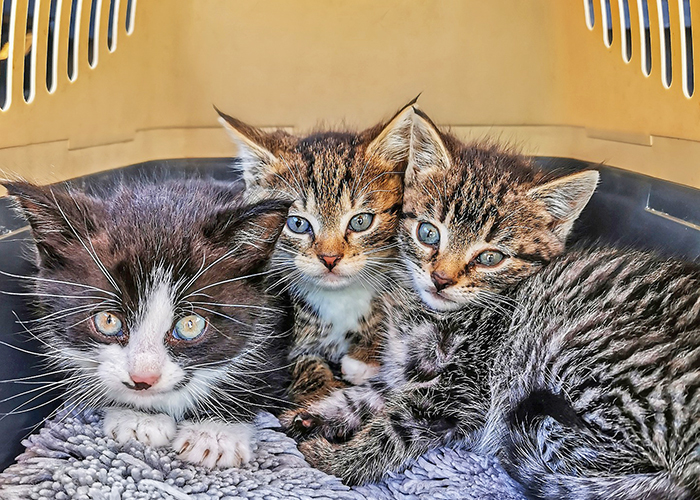Posts in Category: The Cat’s Meow
Fear Free Practices for Furry Friends

For many people, the doctor’s office can be a scary place. So it is no surprise that many pets view going to the vet with a similar fear.
Our clinic truly believes in Fear Free practices. Our goal is to limit your pet’s stress and fear and make visits with us as pleasant as possible. There are various ways that we do this, which I would like to share with you.
Treats, Teats, and More Treats!
During your pet’s visit you will notice that we like to offer treats. We have biscuits, cheese, peanut butter – like a candy store for dogs and cats! This is not only because we think your pet is adorable and we want to spoil them, but this is also a main way we like to bond with them.
Imagine if you are at the doctor and you are anxiously waiting, and then the doctor walks in and immediately offers you your favorite treat (for me, that would be some delicious baked goods) and socializes with you. You would likely feel much calmer and connected to them. This is the equivalent of what we do with your pets.
Although we have lots of treats, if you have a dog or cat that is pickier with food, please feel free to bring whatever your pet likes best. This is not uncommon, as I have seen many patients that would eat only one food.
We encourage owners to offer treats as well during visits to help make the entire experience as positive as possible. We joke that visits go best when our patients come hungry, so you may want to consider bringing your pet to see us with an empty stomach so there is plenty of space for treats!
Getting on Their Level
We want our patients to feel comfortable, so we often will sit on the ground with them. We hope that by sitting on their level they feel less intimidated and fearful, and that they see us as their “friend.” I have noticed that when I sit on the ground and spend time in the room before even beginning my exam, my patients generally seem more at ease.
Please do not feel obligated to sit with us, but if you would like to you are totally welcome!
Limit Stress from Other Pets
Many cats never leave the home except to go to the vet. They may be stressed by traveling before they even arrive.
The smells and sounds of dogs can be very scary for them, too, which is why we recently created a separate feline waiting room and exam rooms. We use all separate supplies, have tasty treats and fun toys, and have nice feline-friendly smells. In the months since we have started using this new space, I have noticed that cats overall seem much calmer and happier.
Dogs can be become upset from other pets as well. Some of the sweetest and most affectionate dogs that I have met do not get along well with other dogs. Being around other dogs is stressful for them. I personally have a dog-reactive dog, and while she loves people, other dogs make her highly anxious.
To reduce this anxiety, we have multiple tactics, such as choosing specific exam rooms and trying to limit time in the clinic and exam room, when other pets are a trigger for the patient. We also perform exams outside in an isolated area if needed.
Fear Free for Your Pet
Please let us know if your pet is reactive with other pets, or there are any other behavioral concerns, and we will work with you to formulate a plan for their visits.
I hope you can see how much we at Medical District Veterinary Clinic truly care about our amazing patients! We look forward to continuing to make their time with us as fun and enjoyable and fear free as possible!
Amber Slaughter, DVM
The Weather Outside Is Fightful

Oh, what a typical December in a year of continual peace and normalcy.
What’s your favorite holiday memory regarding socially distanced Zoom calls with family members you haven’t seen in person for years due to splintered political realities followed by a deadly pandemic all the while keeping your 6-year-old son inside and away from his friends for 9 months and simultaneously being forced to keep an external facade of sanity and light fun in your two-holiday household while your profession, which is universally adored and undervalued at the same time, is more in demand of your time than at any other period in history?
I have so many.
So we know what usually happens here on the holiday. There is a cute blog post about keeping your dogs and cats safe, titled something like “’Tis the Wheezin’: Asthma During the Holidays.” I have written some in the past (HERE), and feel free to read. It generally can be summed up by this wise adage: “Don’t let your dog and cat eat things or get burned and remember that New Year’s Eve in Chicago generally involves people who do not have children and animals lighting off fireworks late at night to make those of us who do angry.” And don’t buy puppies, kittens, or bunnies as gifts. Instead, buy books like this inspirational tale for the animal lover in your life.
But I’m going to write about an unrelated topic: domesticated cats and the outdoors. I can imagine, even before writing this, that many people have strong feelings about this topic. My intention is not to pass judgment on anyone. I want to just give you the veterinarian perspective, and possibly give you an excuse to see photos of my fat indoor cats sitting next to holiday decorations, because that is how we indoor-cat people are generally seen and heard.

Some cats go outside. Cats go outside because some people feel that they have no choice but to let the cat out. Some people feel that it is philosophically cruel to not let the cat out, and some cats get outside by accident. All are acceptable.
I will be upfront and tell you that my two cats, Crocodile the Russian Blue mutt and Penelope the one-eyed tuxedo, do not go outside. They both try at times and have both gotten out before, but they stay inside and tolerate the complete subservience of all surrounding them.
Some of the dangers facing an outdoor cat are pretty obvious, but let’s go through them (you and I, together, like old friends who aren’t being watched):
1. Fighting with Other Cats
Cat bites and scratches are bad, cause severe infections, and can be fatal. All veterinarians have seen cats brought in with bite wounds that have become severely infected and, at worst, can puncture the abdomen, chest, eyeball, or throat and need surgical fix, hospital stays, and even euthanasia. We clean it up and give antibiotics, but it’s always concerning. This also can lead to:
2. Spread of Infectious Disease
Feline leukemia virus (FeLV) and feline immunodeficiency virus (FIV) are spread through the exchange of bodily fluids (blood, saliva, etc.). Let’s just assume that the cats outside getting into fights are mostly ones that are homeless, and that homeless cats comprise the largest population of cats carrying these viral diseases. Well, the logic chain/train follows, and you see the danger. We can vaccinate for FeLV, so if your cat does go outside, you can get this done. There is no vaccine for FIV. And no treatment for either disease.
3. Other Infectious Disease

Rabies is a classic viral hit and can be spread through other cats or wild animals (bats, skunks, foxes). Make sure your outside cat is vaccinated for rabies, not only because it is the law but also because, even though it is rare, your sweet rabid cat can kill you and your family. (Still waiting for the Hallmark Channel’s Very Special Rabies Christmas.)
Just for fun let’s add endless respiratory infections (that can pass on to the other cats in your house), feline distemper (get your cat vaccinated for that, too), and parasitic diseases such as fleas (get monthly flea protection), ticks (get monthly tick protection), ear mites, intestinal worms (have monthly dewormers given), and ringworm.
All but one of these diseases can be passed on to you, your children, your grandparents, their friends, their friends’ neighbor, your friends’ neighbors’ son’s cat, etc. You see how this works. If you have an outdoor cat, and you’re afraid to tell your veterinarian (which you shouldn’t be), you can still take all the precautions: vaccines, preventatives, etc.
4. And Even More Infectious Disease
For the lucky, cats bring home presents, such as mice, birds, rats, etc. The rodents bring diseases and other rodents. It’s endless.
5. Cats Get Hit by Cars…
… get hit by bikers, get stuck in garages, get hurt by bad people, get snagged on fences, freeze to death, etc. [Cut to unwatchable montage of more horrible things.] It happens.
My previous cat got stuck in someone’s garage. I could not find her and searched for hours around the neighborhood. I eventually heard a cat crying in a garage and called the police who, hours later, located the owner who wasn’t on premise, to open the door. That could have easily gone another way, and I will write that fan fiction novel later.
“Lost cat” signs litter my current neighborhood, and you know they aren’t lost with a hobo bag on a train. They are all either dead, or (at best) living their lives with someone else. Also please have your outdoor cats microchipped. It’s not painful and may save your cats’ lives. You can also buy GPS trackers for their collars. I am not promoting a specific brand, but they are available anywhere.
6. Overpopulation
Cats are really good at making babies, causing the population of stray cats in the city to blow up. These cats either end up being helped by people/shelters that can barely deal with the cats they have or they are left to fend for themselves on the streets to die, starve, or spread more disease.
So first, get your outdoor cat spayed or neutered. It is absolutely the best thing for them, for their health, and to keep down the population of wild cats in need. I also do not need to explain to you how a wild tom cat will treat a sweet young lady cat taking a stroll down the promenade with her uterus and ovaries. If you want to reduce the chances that your boy cat doesn’t get into a fight, well, then neuter. There are conflicting statistics, but most sources suggest that one female cat and her mate and all the subsequent offspring amounts to 11 million cats in nine years.
7. Anti-Nature

Lastly, I fear that some of you feel like the most natural thing for the world is to let your cats outside and let them live the full entirety of their existence. I get this, I really do, but also understand how much destruction to the natural environment cats do. They destroy natural foliage and other wildlife despite their good intentions. There is some very good evidence that the best thing for “nature” is to keep your cats inside, and you can find many other resources on this topic.
There are cats that do better when they go outside. I’ve had clients keep their cats inside and later see them become anxious, yowl, not eat, urinate all over the house, etc. I don’t want your cats to suffer, but if you want to make that transition, there are things we can do. It may not be the case that your cat is anxious because it can’t go outside. In fact, it may be that it has always been anxious, but you never noticed until you kept it inside. Always have us examine your cat before making any judgments. Maybe your formerly outdoor cat is suffering from something else (UTI, pain, etc.).
As always, feel free to discuss with us at any time. This wasn’t meant to be a philosophical treatise on domesticated animals’ rights, though that is generally how I fantasize spending a great deal of my off time.
Try to relax during these times and make sure you don’t feed your dogs chocolate-covered antifreeze-infused garlic balls for the holidays, or give your cats kerosene holiday lamps for Hanukkah.
I will continue to lord over Secret Santas everywhere while I fulfill my long-standing December tradition of making holiday cookies I can’t eat in a house I don’t own.
Be safe, don’t travel, wear masks, and shop locally on-line. And Black Panther is a holiday movie.
— Brett Grossman, DVM
Keeping Indoor Cats Happy
![[cat peeking from under covers]](https://www.medicaldistrictvet.com/blog/wp-content/uploads/2020/09/yallof-happy-cat.jpg)
Cats make great pets for city dwellers; most indoor cats are content to live in small spaces, passing the day asleep on a bed or couch, waking for meals and litter box use. They don’t need to be walked outside and they are a great source of love and companionship. Chicago offers many rescue groups and shelters that can help you select and adopt a life-long friend. PAWS and the Anti-Cruelty Society are two such organizations.
Many indoor cats, however, find confined living stressful and act out in ways that are undesirable to their owners. Two of the most common unwelcome behaviors are eliminating out of the litter box and scratching furniture and rugs.
This article outlines some of the ways to make your indoor cat’s existence happy. Because behavior problems can be rooted in medical causes, be sure to contact your veterinarian if you are concerned about your cat.
Think Inside the Box
Excellent litter box hygiene is essential for curtailing inappropriate urination and defecation. Cats are fastidious, so may choose to avoid using an unkempt box. Eliminating out of the box is not a spiteful behavior; it may be, in the cat’s mind, the best alternative. Removing waste daily is recommended.
Make sure you have enough litter boxes for the number of cats in your home. Veterinarians recommend the number of litter boxes equals the number of cats plus one (e.g., two cats demand three boxes).
Lastly, choosing a litter that is acceptable to your pet can be achieved by trial and error. Most cats prefer a low dust, unscented clumping litter.
Scratching
Cats are natural scratchers; scent-marking glands in their paws announce to the world that a particularly well-upholstered couch or loveseat belongs to them. Their owners, however, may take exception.
There are some interventions that may be helpful to curb this habit. A scratching post, which can be placed either near or distant from a couch, may be an effective alternative. Strategically deposited catnip may lure your cat toward the desired spot. Regular clipping of your cat’s claws may also deter scratching. Additionally, clear tape applied at the arms of a couch is offensive to cats and can turn them off from scratching your furniture.
Vertical Space
Outdoor cats climb trees to get away from predators, chase birds and other small prey, and get some alone time. Indoor cats need a similar escape. A homemade or purchased cat tree is a great way to offer your indoor cat the vertical escape she needs. This multi-level structure with comfortable places to sleep and play is one of the remedies for reducing stress and undesirable behavior in a small city dwelling.
Food, shelter, litter boxes, and love can change the life of an unwanted animal. Consider adding a cat to your home. You may be rewarded with unconditional friendship and love.
Dr. Barrie Yallof
Transport a Calm Cat to the Vet

I recently came across the most amazing carrier for producing a calm cat. It’s called the Van Ness Calm Carrier. It has a sliding drawer design that allows cats in the carrier to be very easily taken out, avoids the more forceful removal from the carrier, and allows for quicker and safer unloading. I was amazed by this simple and genius idea and surprised that this carrier wasn’t more widely used.
For many cats, the only time they leave their homes and see the carrier is when they are going to the vet. They associate the carrier and the departure with being at the vet, and they begin to feel heightened stress and anxiety even before they arrive. Once we see many of these cats, it can be very difficult to handle them, and just getting them out of the carrier can be a challenge.
As a hospital that utilizes Fear Free® practices on a daily basis, we at Medical District Veterinary Clinic do our best to lessen anxiety and stress for our patients before, during, and after their visits to the vet. While the carrier choice seems simple, this important step can make a huge difference in creating a calm cat.
Below are tips to help lessen anxiety and stress for your cats when they visit with us:
- The best carriers are hard sided carriers that can be easily taken apart. In a carrier in which the top can be easily removed, more stressful and fearful cats can even be examined while they remain in the bottom half of the carrier where they are more comfortable.
- Make the carrier comfortable and enjoyable for your cat. Ideally your cat will enter the carrier on their own, and even spend time there to rest and play. To help your cat see the carrier as a happy and positive place, fill it with treats, toys, and familiar bedding that they enjoy.
- A product called Feliway® emits a synthetic feline pheromone that helps create a calming environment and reduces stress. It comes as a plug-in diffuser, spray, and wipe. Use of these products in the carrier prior to transport can be very beneficial to limit the anticipated stress and anxiety of going to the vet. We use these products all the time and see positive changes in our patients.
- Consider asking your veterinarian for a prescription medication you could administer before your cat’s visit to the clinic to serve as a mild sedative and help reduce stress and anxiety. Common medications used include gabapentin and trazodone.
By following these guidelines, you can make the experience of going to the vet much more enjoyable for feline patients—and for owners and veterinary staff as well.
—Amber Slaughter, DVM
